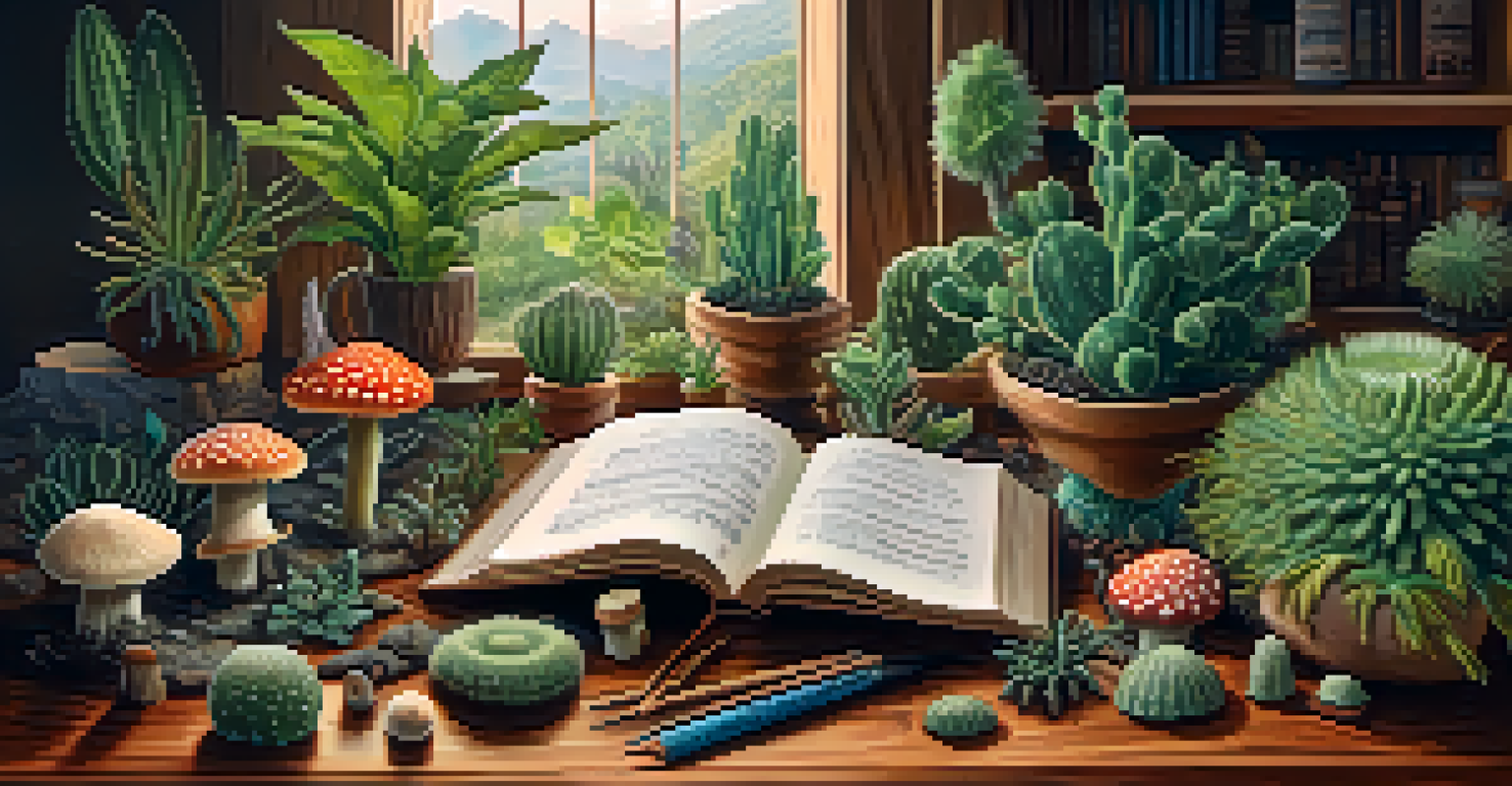Entheogenic Plants: Nature's Tools for Holistic Healing

Understanding Entheogenic Plants and Their Significance
Entheogenic plants are those that have psychoactive properties, often used in spiritual and healing practices. These plants can induce altered states of consciousness, allowing individuals to explore their inner selves and connect with nature. Historically, cultures around the world have revered these plants for their ability to facilitate profound experiences and insights.
The experience of the divine is often a subjective one, expressed through the lens of culture and personal belief.
The term 'entheogen' comes from the Greek words meaning 'generating the divine within.' This definition captures the essence of why many seek out these plants—not just for recreation, but for a deeper understanding of themselves and the universe. Many people report transformative experiences that can lead to emotional healing and personal growth.
With the resurgence of interest in holistic health, entheogenic plants are gaining recognition in modern alternative therapies. As more research emerges, the potential benefits of these plants are being explored in both psychological and spiritual contexts, making them valuable tools in holistic healing.
Common Entheogenic Plants and Their Uses
Some well-known entheogenic plants include psilocybin mushrooms, ayahuasca, and peyote. Each has unique effects and cultural significance, often used in ceremonial contexts. For instance, ayahuasca, a brew made from various Amazonian plants, is traditionally used for deep introspection and healing in many indigenous cultures.

Psilocybin mushrooms, also known as magic mushrooms, have been utilized for centuries in various cultures for their ability to induce vivid imagery and deep emotional experiences. Users often report feelings of interconnectedness and enhanced creativity, contributing to personal insights and emotional healing.
Entheogenic Plants and Healing
Entheogenic plants are gaining recognition for their potential to facilitate emotional healing and personal growth through altered states of consciousness.
Similarly, peyote, a small cactus containing mescaline, has been a part of Native American spiritual practices for millennia. The experiences it offers can lead to a sense of unity with nature and a deeper understanding of one's purpose in life, making it a powerful ally in healing and self-discovery.
The Role of Set and Setting in Healing Experiences
When using entheogenic plants, the concepts of 'set' (mindset) and 'setting' (environment) are crucial for a positive experience. A person's mental state can significantly influence their journey, making it essential to approach these experiences with intention and an open heart. Setting, too, plays a vital role; a safe, comfortable environment can enhance feelings of security and openness.
Psychedelics are not just for the mind, but for the heart, the spirit, and the very essence of being.
Many practitioners emphasize the importance of preparation before engaging with these plants. This might include meditation, journaling, or consulting with experienced guides who can provide support. Such practices help create a conducive mindset, allowing individuals to engage more deeply with their experiences.
Ultimately, the combination of a positive mindset and a nurturing setting can lead to profound healing and transformation. When individuals feel safe and supported, they're more likely to explore the depths of their consciousness and gain valuable insights into their lives.
Entheogenic Plants in Modern Therapy Settings
In recent years, there's been a growing interest in utilizing entheogenic plants in therapeutic settings. Research institutions and clinics are exploring their potential to treat conditions like PTSD, depression, and anxiety. This shift reflects a broader movement towards integrating traditional healing practices with modern psychology.
For example, studies on psilocybin have shown promising results in alleviating anxiety and depression among patients facing terminal illnesses. Participants often report significant shifts in perspective, leading to decreased fear of death and improved emotional well-being. These findings highlight the therapeutic potential of entheogenic plants when used responsibly.
Cultural Respect and Understanding
Different cultures have varied perspectives on entheogenic plants, highlighting the importance of approaching their use with respect and awareness of their cultural significance.
As more clinical trials are conducted and the stigma surrounding these substances diminishes, we may see a new era in mental health treatment. The integration of entheogenic plants into therapy offers hope for many seeking alternative avenues for healing and self-discovery.
Cultural Perspectives on Entheogenic Plant Use
Cultural attitudes toward entheogenic plants vary widely around the world. In some cultures, these plants are sacred, revered as gifts from nature that facilitate communion with the divine. For instance, indigenous tribes in the Amazon view ayahuasca as a teacher, guiding users through their spiritual journeys.
Conversely, in Western societies, these plants have often been misunderstood and stigmatized, primarily due to their association with recreational drug use. However, as education and research spread, more people are beginning to recognize the spiritual and therapeutic potential of these natural substances.
Understanding these differing perspectives can foster greater respect for the traditions surrounding entheogenic plants. By appreciating their cultural significance, we can approach their use with the reverence and mindfulness they deserve, paving the way for deeper connections and healing experiences.
Legal Status and Ethical Considerations
The legal status of entheogenic plants varies significantly across the globe, impacting their accessibility for therapeutic and spiritual use. In some countries, certain plants like ayahuasca and psilocybin mushrooms are legal in specific contexts, while in others, they remain strictly prohibited. This inconsistency can create challenges for those seeking to explore their healing potential.
Ethical considerations also play a role in the conversation around entheogenic plants. It's essential to approach their use with respect for the cultures from which they originate and to avoid cultural appropriation. Engaging with these plants in a responsible manner involves understanding their traditional contexts and honoring the wisdom of Indigenous peoples.
Future of Therapy with Plants
The therapeutic potential of entheogenic plants is being explored in clinical settings, suggesting a promising future for their integration into modern mental health treatments.
As we navigate the evolving landscape of entheogenic plant use, ongoing dialogues around legality and ethics are crucial. By advocating for responsible use and respecting cultural heritage, we can foster an environment that supports holistic healing for all.
The Future of Entheogenic Plants in Healing Practices
The future of entheogenic plants in healing practices looks promising, with a growing body of research supporting their therapeutic benefits. As more people seek alternative approaches to mental health and well-being, these plants may play a pivotal role in redefining how we understand healing. With ongoing studies and increased acceptance, we could see a shift in mainstream mental health treatment.
Educational initiatives aimed at raising awareness about the responsible use of entheogenic plants are also on the rise. Workshops, retreats, and online resources help individuals learn about their potential benefits and risks, promoting safe practices. Such initiatives empower people to approach their healing journeys with knowledge and respect.

Ultimately, the integration of entheogenic plants into holistic healing practices can lead to a more comprehensive understanding of wellness. As we embrace these ancient tools, we open ourselves up to new possibilities for healing and transformation, fostering a deeper connection with ourselves and the world around us.